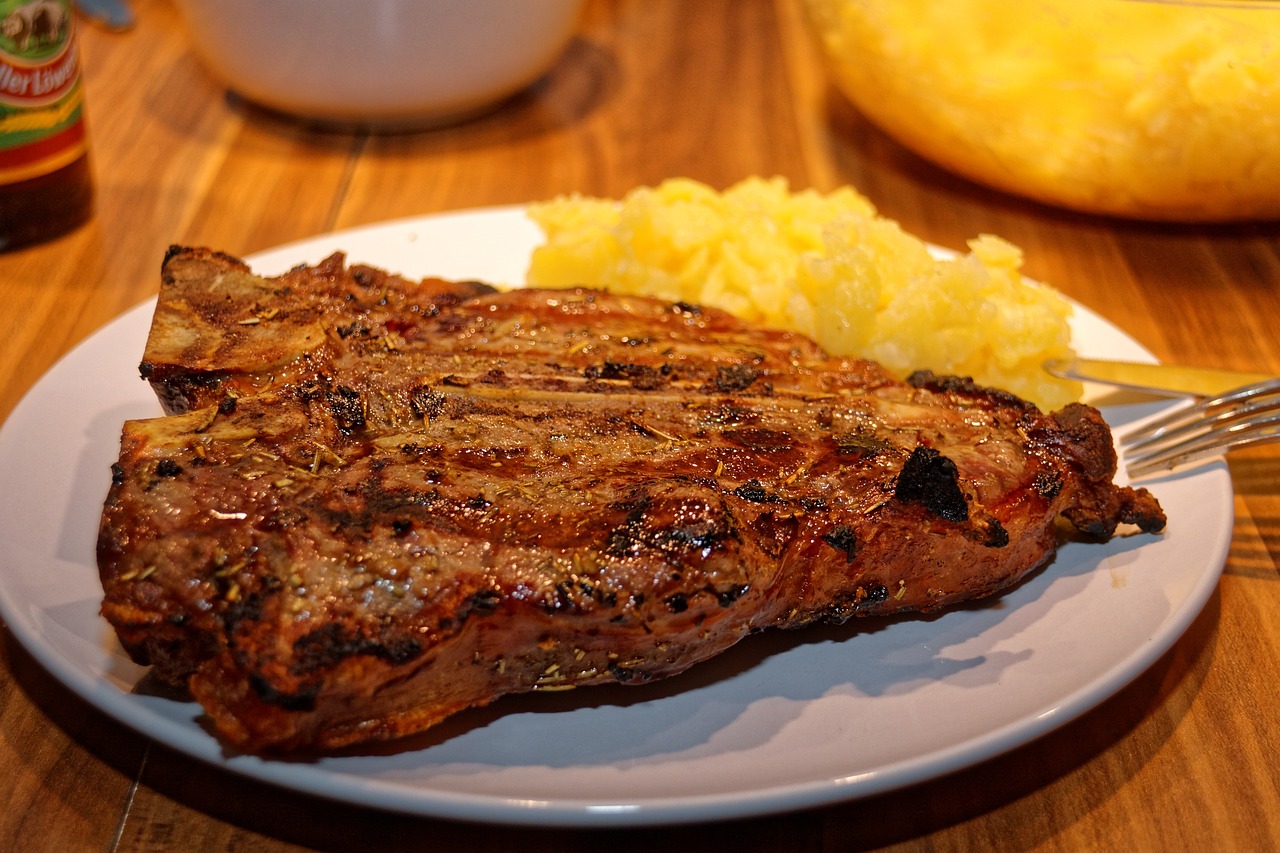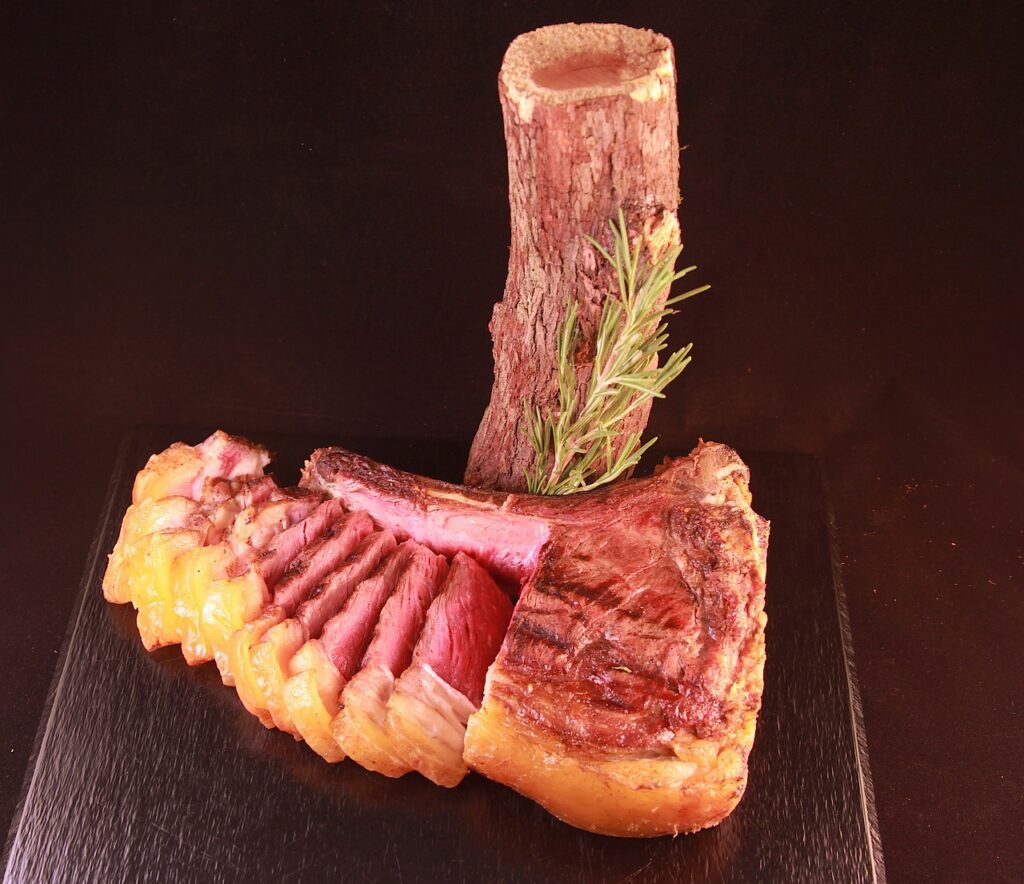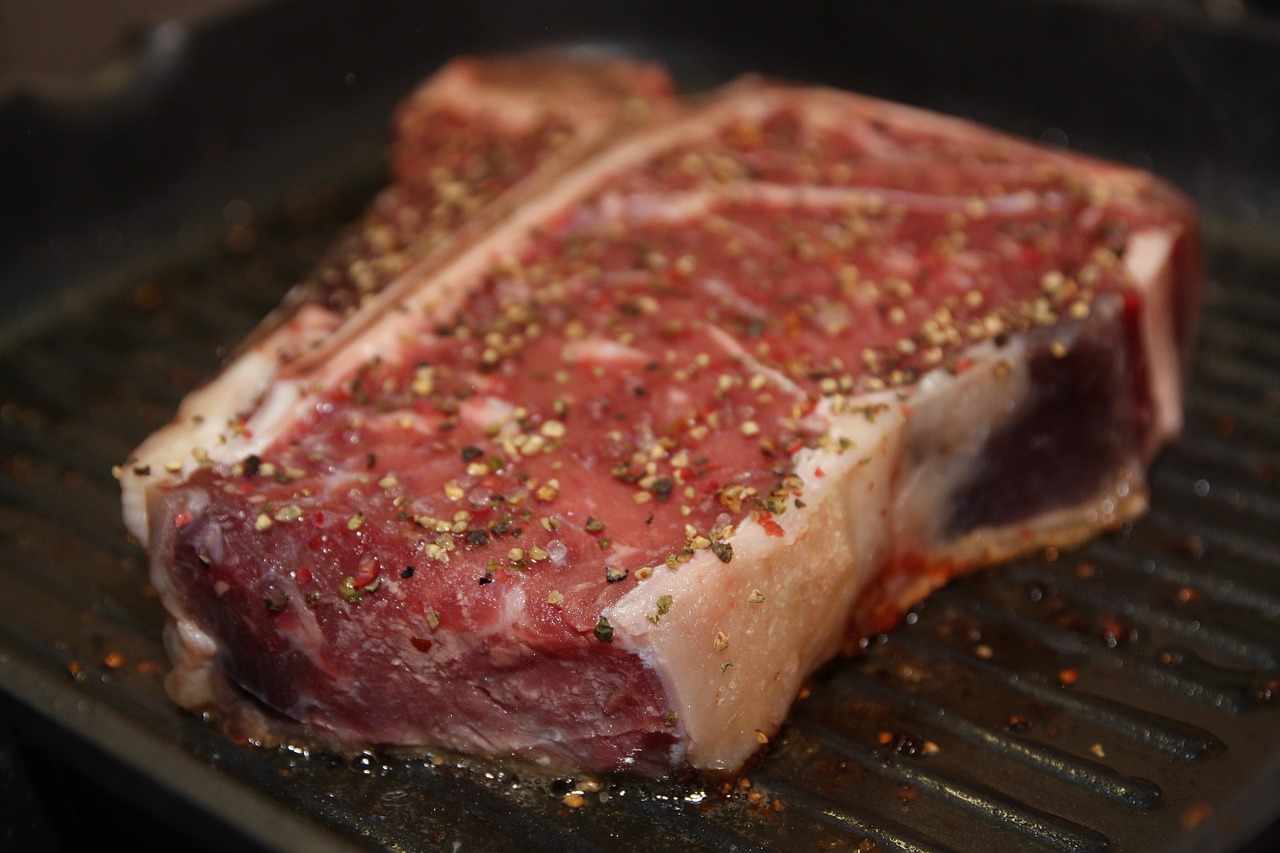T-Bone vs Porterhouse – Introduction
When it comes to indulging in a mouthwatering steak, few cuts rival the satisfaction of sinking your teeth into a juicy, perfectly cooked Porterhouse or T-Bone steak. These two iconic cuts of beef offer a delightful combination of tender filet mignon and flavorful strip steak, making them favorites among meat connoisseurs. In this blog post, we will delve into the battle of Porterhouse vs. T-bone steaks.
Overview Of The T-bone And Porterhouse Steaks
Porterhouse and T-Bone steaks are both taken from the short loin of the cow and are characterized by their distinctive T-shaped bone containing the two parts of the steak. The meat on either side of the bone is different, with one side being the tender filet mignon and the other side being the flavorful strip steak. However, there are some differences between these two cuts.
Porterhouse Steak
A Porterhouse steak is bigger and thicker than a T-Bone steak, usually weighing around 24 to 48 ounces (680 to 1360 grams) and measuring about 1.25 inches wide at its widest point. The generous size of a Porterhouse makes it a showstopper on the plate and a popular choice for sharing. The filet mignon part of the Porterhouse steak is also larger than that of a T-bone steak, adding to its overall size and making it an ideal cut for those who love a more substantial piece of meat.


T-bone Steak
Similar to the Porterhouse, a T-Bone steak combines the filet mignon and the New York strip. The critical difference lies in the size of the filet mignon portion. T-Bone steaks are generally smaller than Porterhouse steaks, usually weighing around 16 to 24 ounces (454 to 680 grams) and measuring about 0.5 to 1 inch wide at its widest point. The smaller size of T-Bone steaks makes them perfect for single servings, and they are often less expensive than Porterhouse steaks.
In conclusion, the Porterhouse and T-Bone steaks offer delicious combinations of tender filet mignon and flavorful strip steak. However, the main differences between these two cuts lie in their size and suitability for sharing. Whether you opt for a Porterhouse or T-Bone steak, both are sure to satisfy any meat lover’s palate.


Introduction
Steak lovers around the world enjoy the taste of a perfectly cooked Porterhouse or T-Bone steak. These two beef cuts are known for their combination of tender filet mignon and flavorful strip steak. In this blog post, we will unravel the Porterhouse Vs. T-Bone steak showdown and compare the two cuts based on their characteristics and cooking methods.
Description Of T-bone Steak And Its Characteristics
A T-Bone steak is taken from the short loin of the cow and is characterized by its T-shaped bone that contains two parts of the meat. One side of the bone is the tenderloin or filet mignon, while the other side is the strip steak. The T-Bone steak is smaller and thinner than a Porterhouse, typically weighing around 16 to 24 ounces (454 to 680 grams) and measuring about 0.5 to 1 inch wide at its widest point. The smaller size makes it ideal for single servings, and they usually cost less than Porterhouse steaks.
T-bone Steak Preparation Methods And Cooking Tips
To cook a T-Bone steak to perfection, here are some cooking tips:
- Take the steak out of the refrigerator and let it sit at room temperature for about 30 minutes before cooking.
- Season the steak with salt and pepper or any other desired seasoning before cooking.
- Preheat the oven to 425°F (218°C).
- Heat a cast-iron skillet over high heat until it becomes scorched hot, then add oil to the pan and let it heat up.
- Place the T-Bone steak in the skillet and sear it on each side for 2-3 minutes for medium-rare or 3-4 minutes for medium doneness.
- Once both sides are seared, transfer the skillet to the preheated oven and cook for 6-8 minutes or until the internal temperature of the meat reaches 130°F (54°C) for medium-rare or 135°F (57°C) for medium doneness.
- Let the steak rest for 5-10 minutes before slicing and serving.
In conclusion, the T-Bone steak is a smaller and thinner cut than the Porterhouse, but it still offers the delightful combination of tender filet mignon and flavorful strip steak. Properly cooking the steak with the tips mentioned above will result in a juicy and delicious meal that any meat lover will enjoy.
What Is A Porterhouse Steak?
A Porterhouse steak is a combination of two different cuts of beef, the tender filet mignon and the robust New York strip. With a generous size and thickness, it is typically served as a showstopper meal and is often shared.
Description Of Porterhouse Steak And Its Characteristics
A Porterhouse steak is a larger and thicker cut of beef than a T-Bone steak, with a weight ranging from 24 to 48 ounces (680 to 1360 grams) and measuring about 1 to 2.25 inches wide at its widest point. The critical difference between a Porterhouse and T-Bone steak lies in the size of the filet mignon portion. A Porterhouse steak has a larger filet portion than a T-Bone, weighing at least 1.25 inches in diameter. It is also a more expensive cut of meat due to its size and tenderness.


Porterhouse Steak Preparation Methods And Cooking Tips
To prepare a perfect Porterhouse steak, follow these cooking tips:
- Take the steak out of the refrigerator and let it sit at room temperature for about an hour before cooking.
- Season the steak with salt and pepper or any other desired seasoning before cooking.
- Preheat the oven to 425°F (218°C).
- Heat a cast-iron skillet over high heat until it becomes scorched hot, then add oil to the pan and let it heat up.
- Place the Porterhouse steak in the skillet and sear it on each side for 3-4 minutes for medium-rare or 4-5 minutes for medium doneness.
- Once both sides are seared, transfer the skillet to the preheated oven and cook for 6-10 minutes or until the internal temperature of the meat reaches 135°F (57°C) for medium-rare or 145°F (63°C) for medium doneness.
- Let the steak rest for 5-10 minutes before slicing and serving.
In conclusion, the Porterhouse and the T-Bone steaks are both popular cuts of beef that offer a combination of tenderloin or filet mignon and strip steak. A Porterhouse steak is larger and thicker, with a larger portion of the tenderloin. By following the cooking tips provided, anyone can cook a perfect Porterhouse steak and satisfy their meat cravings.
Differences Between T-bone And Porterhouse Steaks
Size And Shape Differences
Porterhouse and T-Bone steaks share many similarities, including a T-shaped bone with meat on each side. However, the critical difference between the two cuts lies in the size of the filet mignon portion. A Porterhouse steak has a larger filet portion than a T-Bone, weighing at least 1.25 inches in diameter, while T-Bones usually have a filet portion weighing less than an inch in diameter. In addition, Porterhouse steaks are generally larger than T-Bones, with a weight ranging from 24 to 48 ounces (680 to 1360 grams) and measuring about 1 to 2.25 inches wide at its widest point. These characteristics make Porterhouse steaks ideal for sharing and showcasing on the plate.
Price Differences
Due to its larger size and higher quality filet portion, Porterhouse steaks are usually more expensive than T-Bones. However, the exact price difference depends on the location and the quality of the meat. In general, Porterhouse steaks are considered a luxury cut of beef, while T-Bones are a more affordable option.
When preparing either cut of steak, it is essential to follow appropriate cooking methods and tips to ensure the most enjoyable dining experience. While both steaks offer a combination of tenderloin or filet mignon and strip steak, the larger filet portion of a Porterhouse steak can achieve a more substantial and tender bite. On the other hand, T-Bones are a satisfying and affordable alternative for those who want a delicious and well-rounded steak.
In conclusion, understanding the differences between Porterhouse and T-Bone steaks can provide an informed choice when selecting your next indulgent meal. The right cut of steak depends on your personal preference and the occasion, and either choice promises a delightful and satisfying dining experience.
Choosing Between T-bone And Porterhouse Steaks
Factors To Consider When Choosing Between The Two Steaks
When it comes to choosing between T-Bone and Porterhouse steaks, several factors must be considered. Here are some things to keep in mind:
Size And Shape Differences
Both T-Bone and Porterhouse steaks feature a T-shaped bone with meat on each side. However, the critical difference between the two is the size of the filet mignon portion. A Porterhouse steak has a larger filet portion than a T-Bone, weighing at least 1.25 inches in diameter, while T-Bones usually have a filet portion weighing less than an inch in diameter. In addition, Porterhouse steaks are generally larger than T-Bones, with a weight ranging from 24 to 48 ounces (680 to 1360 grams) and measuring about 1 to 2.25 inches wide at its widest point. These characteristics make Porterhouse steaks ideal for sharing and showcasing on the plate.
Price Differences
Due to its larger size and higher quality filet portion, Porterhouse steaks are usually more expensive than T-Bones. However, the exact price difference depends on the location and the quality of the meat. In general, Porterhouse steaks are considered a luxury cut of beef, while T-Bones are a more affordable option.
When preparing either cut of steak, it is essential to follow appropriate cooking methods and tips to ensure the most enjoyable dining experience. While both steaks offer a combination of tenderloin or filet mignon and strip steak, the larger filet portion of a Porterhouse steak can achieve a more substantial and tender bite. On the other hand, T-Bones are a satisfying and affordable alternative for those who want a delicious and well-rounded steak.
In conclusion, understanding the differences between Porterhouse and T-Bone steaks can provide an informed choice when selecting your next indulgent meal. The right cut of steak depends on your personal preference and the occasion, and either choice promises a delightful and satisfying dining experience.
Tasting The Steaks
Comparing Flavors, Textures, And Overall Taste
When it comes to the battle of Porterhouse versus T-Bone steaks, both cuts offer a fantastic combination of flavors with the tender filet mignon and the flavorful strip steak. While these cuts offer similar taste profiles, they differ in texture and size.
In terms of flavor, both porterhouse and T-bone steaks have a milder beefiness compared to ribeye. However, these cuts make up for it in texture. Since these muscles receive little exercise, they are very tender when cooked, making them perfect for meat lovers. Test cooks describe porterhouse and T-bone steaks as two-for-the-price-of-one, providing the best of all worlds for both taste and texture.
When choosing between T-Bone and Porterhouse steaks, the size and shape differences must be considered. Both steaks feature a T-shaped bone with meat on each side. However, the critical difference between the two is the size of the filet mignon portion. A Porterhouse steak has a larger filet portion than a T-Bone, weighing at least 1.25 inches in diameter, while T-Bones usually have a filet portion weighing less than an inch in diameter. In addition, Porterhouse steaks are generally larger than T-Bones, with a weight ranging from 24 to 48 ounces (680 to 1360 grams) and measuring about 1 to 2.25 inches wide at its widest point. These characteristics make Porterhouse steaks ideal for sharing and showcasing on the plate.
Regarding price, porterhouse steaks are typically more expensive than T-Bones due to their larger size and higher quality filet portion. However, the exact price difference depends on the meat’s quality and location, with porterhouse steaks being considered a luxury cut of beef and T-Bones a more affordable option.


In conclusion, when preparing either cut of steak, it is essential to follow appropriate cooking methods and tips to ensure the most enjoyable dining experience. Both steaks offer a combination of tenderloin or filet mignon and strip steak, with the larger filet portion of Porterhouse steak achieving a more substantial and tender bite. On the other hand, T-Bones are a satisfying and affordable alternative for those who want a delicious and well-rounded steak. Understanding the differences between Porterhouse and T-Bone steaks can provide an informed choice when selecting your next indulgent meal. The right cut of steak depends on your personal preference and the occasion, and either choice promises a delightful and satisfying dining experience.
Health Considerations
Nutritional Content Of T-bone And Porterhouse Steaks
When it comes to nutritional content, both T-Bone and Porterhouse steaks are excellent sources of protein, which is essential for building and repairing muscle tissue. A 3.5-ounce (100-gram) serving of T-Bone steak contains approximately 26 grams of protein, while Porterhouse steak contains around 25 grams. Both cuts are also rich in essential vitamins and minerals, such as iron, zinc, and vitamin B12.
It is worth noting that the nutritional content of steaks can vary depending on factors such as the animal’s diet, the cut’s thickness and marbling, and the cooking method used. While these cuts can be a part of a healthy diet, it is crucial to consume red meat in moderation as excessive consumption may lead to adverse health effects.
Health Risks Associated With Consuming Red Meat
Consuming red meat, including T-Bone and Porterhouse steaks, has been linked to several health risks. Studies have suggested that high consumption of red meat can increase the risk of cancer, heart disease, type 2 diabetes, and other chronic conditions.
The risks associated with red meat consumption are thought to be due to its high content of saturated and trans fats, which may raise cholesterol levels and clog arteries, leading to heart disease. Additionally, red meat is also high in heme iron, which has been linked to an increased risk of cancer.
While the occasional indulgence in T-Bone or Porterhouse steak may not be a cause for concern, it is essential to consume red meat in moderation and balance it with a varied and healthy diet. If you are concerned about the health risks associated with red meat consumption, consider incorporating leaner cuts of meat into your diet or replacing some red meat meals with plant-based alternatives.
Frequently Asked Questions
Common Questions About T-bone And Porterhouse Steaks
Health Considerations
When analyzing the nutritional content of T-Bone and Porterhouse steaks, it is essential to note that both cuts are excellent sources of protein. A 3.5-ounce serving of T-Bone steak contains approximately 26 grams of protein, while Porterhouse steak contains around 25 grams. They are also rich in nutrients such as iron, zinc, and vitamin B12.
Nevertheless, it is crucial to consume red meat in moderation as excessive consumption may lead to adverse health effects. Consuming red meat, including T-Bone and Porterhouse steaks, has been linked to several health risks such as cancer, heart disease, type 2 diabetes, and other chronic conditions. Red meat consumption has high levels of saturated and trans fats that may raise cholesterol levels and clog arteries, leading to heart disease. Additionally, red meat is high in heme iron, which has been associated with an increased risk of cancer.
It is advisable to incorporate leaner cuts of meat into your diet or replace some red meat meals with plant-based alternatives if you are worried about the health risks associated with red meat consumption. In any case, indulging in T-Bone or Porterhouse steak on an occasional basis shouldn’t be a cause for concern, but it is essential to consume red meat in moderation and balance it with a healthy and varied diet.
Frequently Asked Questions
Common Questions About T-bone And Porterhouse Steaks
Both T-Bone and Porterhouse steaks are popular choices among meat lovers, but there are some differences between the two cuts that people often inquire about. Here are some common questions about T-Bone and Porterhouse steaks:
- What is the difference between T-Bone and Porterhouse steaks?T-Bone and Porterhouse steaks are similar in that they both combine two cuts of beef: the tenderloin and the strip steak. The critical difference between the two cuts is the size of the tenderloin portion. A Porterhouse steak has a larger tenderloin section than a T-Bone steak, making it a better choice for those who prefer a larger portion of tender meat.
- Which one is more expensive?The price of T-Bone and Porterhouse steaks varies depending on factors such as the quality of the meat and where you buy it. However, generally speaking, Porterhouse steaks tend to be more expensive than T-Bone steaks due to their larger size and higher proportion of premium meat.
Health Considerations
When it comes to the nutritional value of T-Bone and Porterhouse steaks, both cuts are excellent sources of protein and vital nutrients like iron, zinc, and vitamin B12. However, consuming red meat, including these two steaks, has been associated with health risks such as heart disease and cancer.
It is crucial to consume red meat in moderation and balance it with a healthy and varied diet. If you are worried about the health risks associated with red meat consumption, you can incorporate leaner cuts of meat into your diet or replace some red meat meals with plant-based alternatives.
Conclusion
Summary Of The Differences Between T-bone And Porterhouse Steaks And Which To Choose Based On Personal Preferences.
In summary, T-Bone and Porterhouse steaks are both delicious and flavorful cuts of meat that offer a combination of the tenderloin and the strip steak. The critical difference between the two cuts is the size of the tenderloin portion, with the Porterhouse having a more substantial tenderloin section. The choice between T-Bone and Porterhouse steaks ultimately depends on personal preference, with those who prefer a larger portion of tender meat opting for Porterhouse steaks. It is essential to consume red meat in moderation and balance it with a healthy and varied diet to minimize the health risks associated with its consumption.
Q: Are T-Bone and Porterhouse the same steak?
A: No, T-Bone and Porterhouse are not the same steak. They are two different cuts of steak that come from the same area of the cow.
Q: How do you tell the difference between T-Bone and Porterhouse steaks?
A: The easiest way to tell the difference is by looking at the size of the tenderloin portion of the steak. Porterhouse steaks have a larger tenderloin portion than T-Bone steaks.
Q: Which one is more expensive, T-Bone or Porterhouse?
A: Generally, Porterhouse steaks are more expensive than T-Bone steaks due to their larger tenderloin portion. However, the price can vary depending on the quality of the meat and the location you are buying it from.
Q: Can they be prepared in the same way?
A: While they are both delicious grilled or broiled, they may require slightly different cooking times due to their different sizes and proportions of fat and meat.
Q: Which one is better for a certain type of meal?
A: If you prefer more tender and flavorful meat, Porterhouse may be the better choice due to its larger tenderloin portion. However, if you prefer a leaner steak with a smaller tenderloin portion, T-Bone may be a better option.
Q: What are some other considerations to keep in mind when choosing between the two?
A: It’s important to consider the size of the steak, your personal preferences, and the occasion for the meal. Additionally, some people may have a preference for one over the other due to flavor or texture differences.



Hey there! If you’re a fan of authentic Mexican cuisine, you’re in for a treat with Humberto Cruz at pointcafeny.com. They take immense pride in serving their customers with home-cooked, genuine Mexican dishes crafted with the finest ingredients. From flavorful salsa to mouthwatering tamales and enchiladas, they offer an experience that brings the taste of family food from back home right to your table. Don’t forget to check out their tempting Daily Specials for a delightful culinary adventure!
